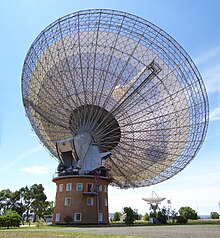It’s funny how you can ignore the resources around you. Here I am, a University of Minnesota graduate (and the ‘M’ is a big, national-calibre school), I’m living barely a mile from their St. Paul campus, and only a few from the Minneapolis campus, which is where I actually went to classes, and yet have I taken advantage of that proximity?
Not that I can remember. I have resolutely ignored ‘M’ for years, especially its Alumnae Society or whatever it’s called. I should probably look back with some regret, if I were smart about such things, but I’m not a joiner and I was never academically competent. I balled up more tests than I can count. Shit, I failed a take-home final once. (Still got a B in the course. It was a CSci course, Numerical Analysis, taught by a first year professor. I think enough students complained that the school ‘adjusted’ some grades.)

The Parkes Observatory, where a number of FRBs have been observed.
But when an alumnae notice came around that mentioned a guest lecture on FRBs, it finally shook me out of my hole and made me look up at the stars, the appropriate thing to do, because FRB stands for Fast Radio Burst, an astronomical phenomenon in which radio bursts which last a few milliseconds suddenly pop up in the data of radio telescopes. The lecture was given Wednesday, April 18th, by Professor Victoria Kaspi of McGill University, Montreal, and she pitched it at an educated but non-specialist audience, and though it was clear she’s not an expert presenter, she was spirited, has a sense of humor, and really made it a fun and educational hour and a half.
She explained not only that their origination points, which are hard to determine, are quite far out, but how they know this. We know that in a perfect vacuum, radiation, whether it be visible light, x-rays, or radio waves, travel at the same speed. But even open space is not a perfect vacuum, it has free electrons floating around. Why is this important? Because they will diffract the radiation, and what happens is that the lower frequencies will move slower. I tried to find one of her beautiful graphs of a signal coming in, but no luck, so you’ll have to imagine a graph of frequencies on the Y-axis and time on the X-Axis. An FRB will start in the high frequencies, but as a few milliseconds pass, the signal falls in a slight curve into the lower frequencies. Through independent means they have rough estimates of the densities of the free electrons in most directions, so combining the graph with the free electron densities gives them an estimate of the distance from the source to Earth.
She also explained how a microwave oven was spooking them at noon some days. That was a hoot.

The CHIME radio telescope
Finally, she mentioned the CHIME radio telescope, currently nearing completion, up in British Columbia. Originally designed and built by cosmologists, the astronomers are hitching a ride on it in the hopes that FRBs show up in the radiation band it’ll be monitoring, which I believe is in the 400 – 800 MHz. The FRBs so far measured have been around 1200 MHz – 1600 MHz, if memory serves, but they have their hopes.
And the origin of FRBs? Professor Kaspi said she was agnostic on that point. Many theories have come and gone, and I think at this juncture they’re just too short on information to have a strong guess.
But great fun!




